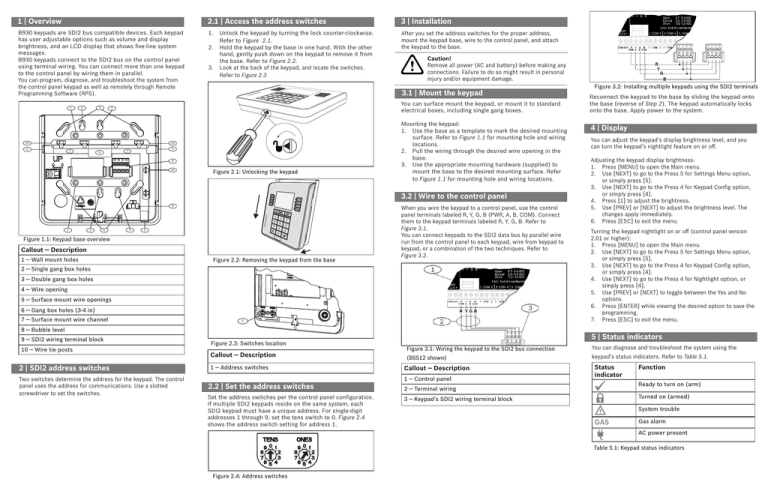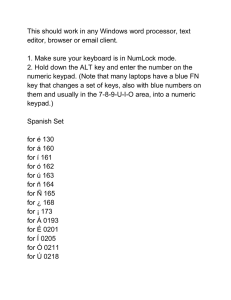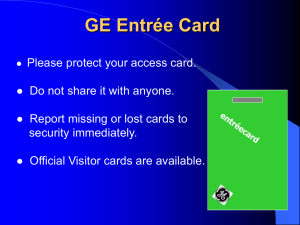
1 | Overview
2.1 | Access the address switches
3 | Installation
B930 keypads are SDI2 bus compatible devices. Each keypad
has user adjustable options such as volume and display
brightness, and an LCD display that shows five-line system
messages.
B930 keypads connect to the SDI2 bus on the control panel
using terminal wiring. You can connect more than one keypad
to the control panel by wiring them in parallel.
You can program, diagnose, and troubleshoot the system from
the control panel keypad as well as remotely through Remote
Programming Software (RPS).
1. Unlock the keypad by turning the lock counter-clockwise.
Refer to Figure 2.1.
2. Hold the keypad by the base in one hand. With the other
hand, gently push down on the keypad to remove it from
the base. Refer to Figure 2.2.
3. Look at the back of the keypad, and locate the switches.
Refer to Figure 2.3
After you set the address switches for the proper address,
mount the keypad base, wire to the control panel, and attach
the keypad to the base.
1
6
3
3.1 | Mount the keypad
You can surface mount the keypad, or mount it to standard
electrical boxes, including single gang boxes.
2
10
10
5
5
7
7
4
Caution!
Remove all power (AC and battery) before making any
connections. Failure to do so might result in personal
injury and/or equipment damage.
9
10
Figure 2.1: Unlocking the keypad
Mounting the keypad:
1. Use the base as a template to mark the desired mounting
surface. Refer to Figure 1.1 for mounting hole and wiring
locations.
2. Pull the wiring through the desired wire opening in the
base.
3. Use the appropriate mounting hardware (supplied) to
mount the base to the desired mounting surface. Refer
to Figure 1.1 for mounting hole and wiring locations.
3.2 | Wire to the control panel
8
1
2
6
3
5
Figure 1.1: Keypad base overview
Callout ― Description
1 ― Wall mount holes
Figure 2.2: Removing the keypad from the base
When you wire the keypad to a control panel, use the control
panel terminals labeled R, Y, G, B (PWR, A, B, COM). Connect
them to the keypad terminals labeled R, Y, G, B. Refer to
Figure 3.1.
You can connect keypads to the SDI2 data bus by parallel wire
run from the control panel to each keypad, wire from keypad to
keypad, or a combination of the two techniques. Refer to
Figure 3.2.
2 ― Single gang box holes
3 ― Double gang box holes
4 ― Wire opening
5 ― Surface mount wire openings
6 ― Gang box holes (3-4 in)
7 ― Surface mount wire channel
1
8 ― Bubble level
9 ― SDI2 wiring terminal block
10 ― Wire tie posts
2 | SDI2 address switches
Two switches determine the address for the keypad. The control
panel uses the address for communications. Use a slotted
screwdriver to set the switches.
Figure 2.3: Switches location
Callout ― Description
1 ― Address switches
2.2 | Set the address switches
Set the address switches per the control panel configuration.
If multiple SDI2 keypads reside on the same system, each
SDI2 keypad must have a unique address. For single-digit
addresses 1 through 9, set the tens switch to 0. Figure 2.4
shows the address switch setting for address 1.
Figure 3.2: Installing multiple keypads using the SDI2 terminals
Reconnect the keypad to the base by sliding the keypad onto
the base (reverse of Step 2). The keypad automatically locks
onto the base. Apply power to the system.
4 | Display
You can adjust the keypad’s display brightness level, and you
can turn the keypad’s nightlight feature on or off.
Adjusting the keypad display brightness:
1. Press [MENU] to open the Main menu.
2. Use [NEXT] to go to the Press 5 for Settings Menu option,
or simply press [5].
3. Use [NEXT] to go to the Press 4 for Keypad Config option,
or simply press [4].
4. Press [1] to adjust the brightness.
5. Use [PREV] or [NEXT] to adjust the brightness level. The
changes apply immediately.
6. Press [ESC] to exit the menu.
Turning the keypad nightlight on or off (control panel version
2.01 or higher):
1. Press [MENU] to open the Main menu.
2. Use [NEXT] to go to the Press 5 for Settings Menu option,
or simply press [5].
3. Use [NEXT] to go to the Press 4 for Keypad Config option,
or simply press [4].
4. Use [NEXT] to go to the Press 4 for Nightlight option, or
simply press [4].
5. Use [PREV] or [NEXT] to toggle between the Yes and No
options.
6. Press [ENTER] while viewing the desired option to save the
programming.
7. Press [ESC] to exit the menu.
5 | Status indicators
Figure 3.1: Wiring the keypad to the SDI2 bus connection
You can diagnose and troubleshoot the system using the
(B5512 shown)
keypad’s status indicators. Refer to Table 5.1.
Callout ― Description
1 ― Control panel
Status
indicator
Function
Ready to turn on (arm)
2 ― Terminal wiring
Turned on (armed)
3 ― Keypad’s SDI2 wiring terminal block
System trouble
GAS
Gas alarm
AC power present
Table 5.1: Keypad status indicators
Figure 2.4: Address switches
6 | Audible tones
7 | Supervision
The keypad has a built-in speaker that produces several distinct
warning tones. The keypad backlight illuminates when it emits
an audible tone.
The control panel supervises all keypads on the SDI2 bus.
If a supervised keypad fails to respond to the control panel,
the control panel declares a Missing Keypad Trouble. When
the control panel can again communicate with the keypad,
it restores the Missing Keypad Trouble. During a Missing
Keypad Trouble, any connected keypad that maintained
contact with the control panel shows the Missing Keypad
Trouble as its idle text, and shows the missing keypad’s
address. The communicating keypads also sound a trouble
tone. Users can silence the trouble tone. If no other troubles
exist, the tone silences when the missing keypad restores.
Tone
Description
Fire alarm
When an area is in fire alarm, the keypad
emits a pulsed, high-pitched bell tone.
Gas alarm
When a gas point activates, the keypad
emits a unique high pitched tone.
User alarm
When a user alarm (such as panic and
medical alarms) occurs, the tone sounds
for the programmed amount of time.
Burglary alarm
When an area is in alarm, the keypad
emits a steady, high pitched bell tone.
Entry delay
The keypad emits an intermittent beep
tone during entry delay periods to remind
the user to disarm the area.
Exit delay
The keypad emits an intermittent beep
tone during exit delay.
Invalid button
buzz
When an invalid button, or sequence of
buttons, is pressed, the keypad emits a
flat buzz tone.
Keypress
The keypad emits a muted beep tone as
each button is pressed to indicate that
the entry was accepted.
Trouble
Watch point
fault
When a trouble event occurs, such as a
service alert, the keypad emits a two-tone
warble until you enter a programmed
passcode with the appropriate authority.
A single clean tweedle tone alerts the
user anytime a watch point is faulted.
Table 6.1: Keypad audible tones
11 | Specifications
Dimensions
6.2 in x 4.7 in x 1 in
(158 mm x 120 mm x 26 mm)
Voltage (input)
12 VDC nominal
Current
35 mA in standby mode
80 mA in alarm mode
Operating temperature
0°C to +50°C (+32°F to +122°F)
Relative humidity
5% to 93% at +32°C (+90°F) noncondensing
Terminal wire size
8 | Show the firmware version
12 AWG to 22 AWG (2 mm to 65
mm)
SDI2 wiring
Showing the keypad firmware version:
1. Remove the keypad from the base to remove power to the
keypad. Refer to Figures 2.1 and 2.2.
2. Return the keypad to the base to restore power.
The keypad shows the model number, keypad address, and
firmware version for 10 seconds.
Maximum distance - wire size
(unshielded wire only):
1000 ft (305 m) - 22 AWG (0.65
mm)
Compatibility
B9512G/B9512G-E
B8512G/B8512G-E
B6512
B5512
B4512
B3512
D9412GV4 version 2.0 and higher
D7412GV4 version 2.0 and higher
(Refer to the control panel
installation document for number
of supported devices.)
NOTICE!
You can also view a keypad’s firmware version in RPS.
9 | Keypad cleaning
Use a soft cloth and non-abrasive cleaning solution to clean your
keypad (for example, microfiber cloth and eyeglass cleaner).
Spray the cleaner onto the cloth. Do not spray cleaners directly
onto the keypad.
10 | Certifications
Region
Certification
US
UL 365 - Police Station Connected Burglar Alarm
Units and Systems
UL 609 - Local Burglar Alarm Units and Systems
UL 985 - Household Fire Warning System Units
UL 1023 - Household Burglar-Alarm System Units
ATM Style Alphanumeric Keypad (SDI2)
B930
en Installation Guide
Copyright
This document is the intellectual property of Bosch Security
Systems, Inc. and is protected by copyright. All rights reserved.
Trademarks
All hardware and software product names used in this
document are likely to be registered trademarks and must be
treated accordingly.
Bosch Security Systems, Inc. product manufacturing dates
Use the serial number located on the product label and refer to
the Bosch Security Systems, Inc. website at
http://www.boschsecurity.com/datecodes/.
UL 1076 - Proprietary Burglar Alarm Units and
Systems
UL 1610 - Central Station Burglar Alarm Units
CSFM - California Office of The State Fire Marshal
FCC Part 15 Class B
CA
Canada CAN/ULC S303 - Local Burglar Alarm
Units and Systems
CAN/ULC S304 - Signal Receiving Centre and
Premise Alarm Control Units
ULC-ORD C1023 - Household Burglar Alarm
System Units
Bosch Security Systems, Inc.
130 Perinton Parkway
Fairport, NY 14450
USA
www.boschsecurity.com
ULC-ORD C1076 - Proprietary Burglar Alarm
Units and Systems
ICES-003 - Digital Apparatus
© 2016 Bosch Security Systems, Inc.
F01U.265.451 | 05 | 2016.04


